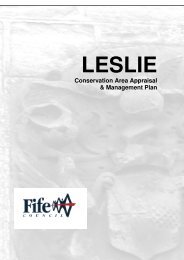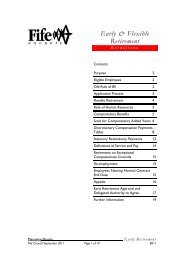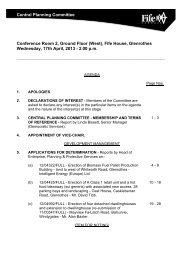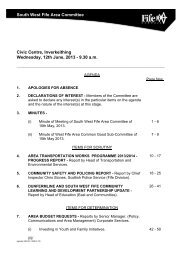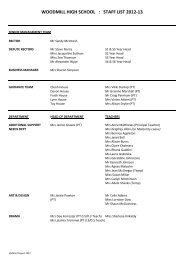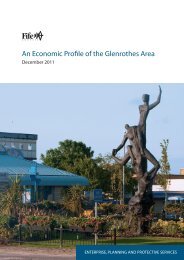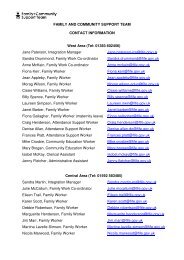Fife Multi-Agency Adult Protection Guidance - Home Page
Fife Multi-Agency Adult Protection Guidance - Home Page
Fife Multi-Agency Adult Protection Guidance - Home Page
Create successful ePaper yourself
Turn your PDF publications into a flip-book with our unique Google optimized e-Paper software.
settings because there is the opportunity to keep the harm hidden; thepresence of others can lead to intervention and sanctions.• Shared living situation: this situation can provide a major risk toindividuals because of the increased opportunities for contact. The riskof harm may be increased from staff and other service users in sharedsettings.• Where a carer experiences mental illness or misuses alcohol there maybe an increased risk of harm to a dependent adult.• Where the carer is heavily dependent on the individual there may be anincreased risk of harm.• Behaviour that challenges others: the individual who displayschallenging behaviour, particularly someone with a learning disabilityand/or communication difficulties, may be at increased risk of harm tothemselves and to others.It is important to be aware that harm can take place with or without anyof these factors being in place.1.4 Signs of harmAbrasions: particularly suspicious are tears to the skin on parts of the bodyother than the arms and legs. May indicate physical harm or neglect.Bruises: the pattern of the bruise can indicate the cause e.g. finger pattern orfist mark may be retained. “Tramline bruising”; parallel bruises indicative ofinjury from a stick. Non-accidental injury bruising is more common on face,neck, stomach, chest and buttocks.Fractures: these may result from falls therefore it is important to check recordsfor relevant details. Fractures of head, spine or trunk are more likely to be theresult of physical harm than fractures to limbs.Pressure sores: these may be an indicator of neglect, especially if the soreshave not been brought to the attention of medical staff.Malnutrition: there are a variety of factors that can lead to malnutrition: failureto respect cultural food preferences leading to food refusal; the effect ofmedication on appetite suppression; poor oral hygiene leading to eatingdifficulties; insufficient care staff to assist individuals with eating difficulties.Malnutrition may be an indicator of neglect.Dehydration: may be a consequence of lack of staff support to maintain fluidintake; failure to provide liquids or to recognise the consequences ofinadequate intake. Dehydration may be an indicator of neglect.Misadministration of medication: incorrect administration of medication or overmedication to control the individual may indicate neglect or physical harm.Burns: research suggests that burns in older people may be an indicator ofneglect or physical harm. Burns may also result from self-neglect.14



